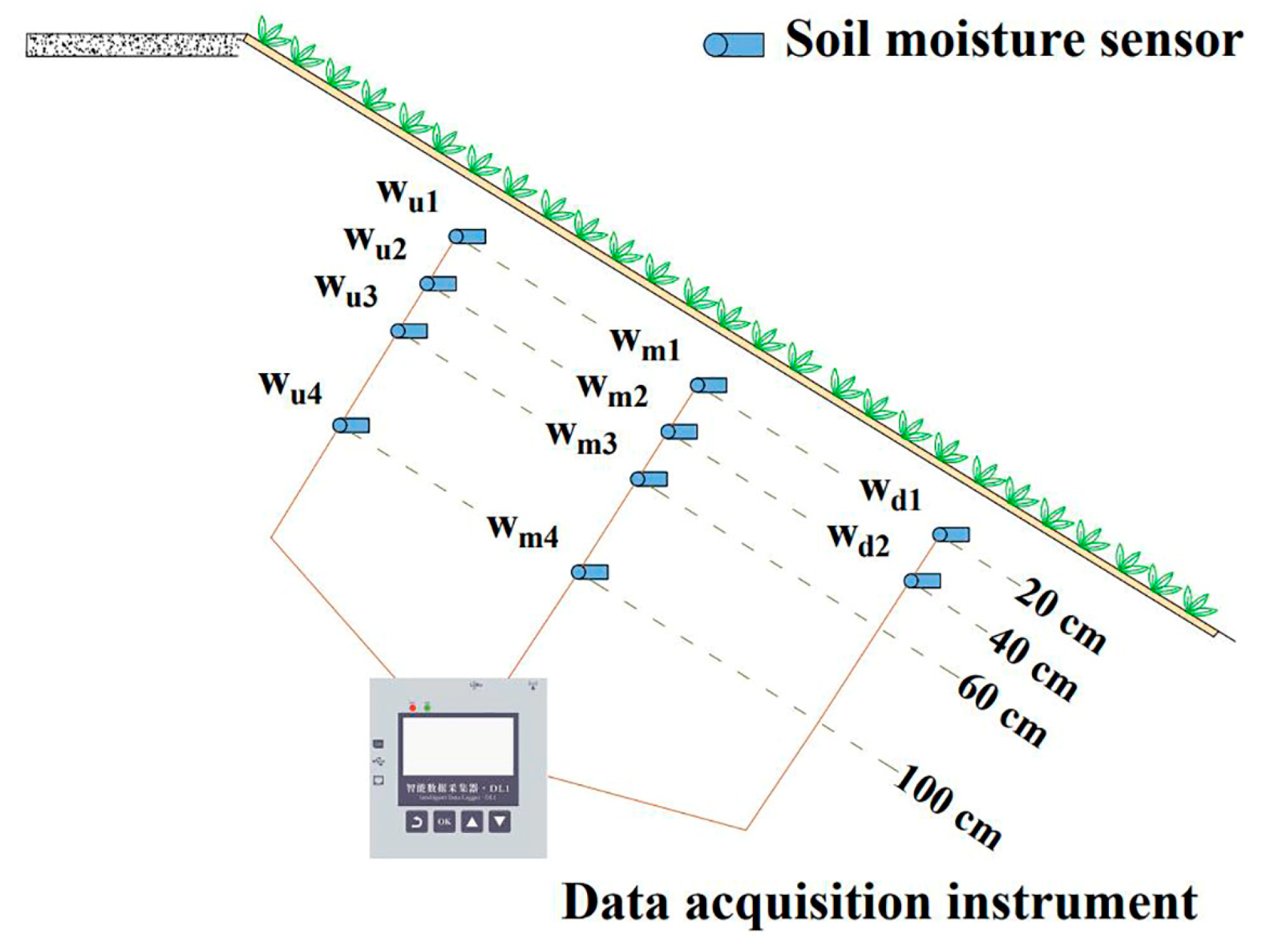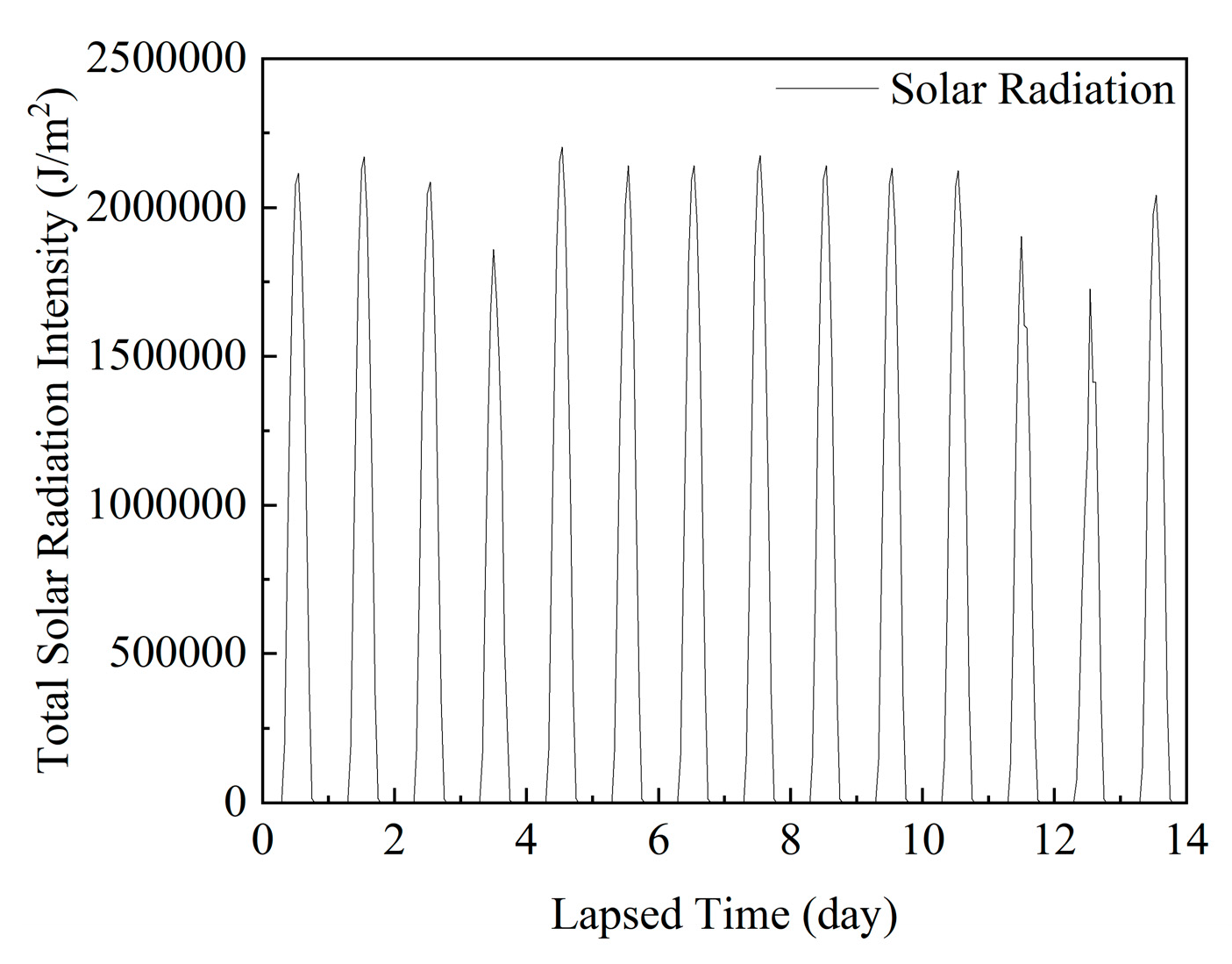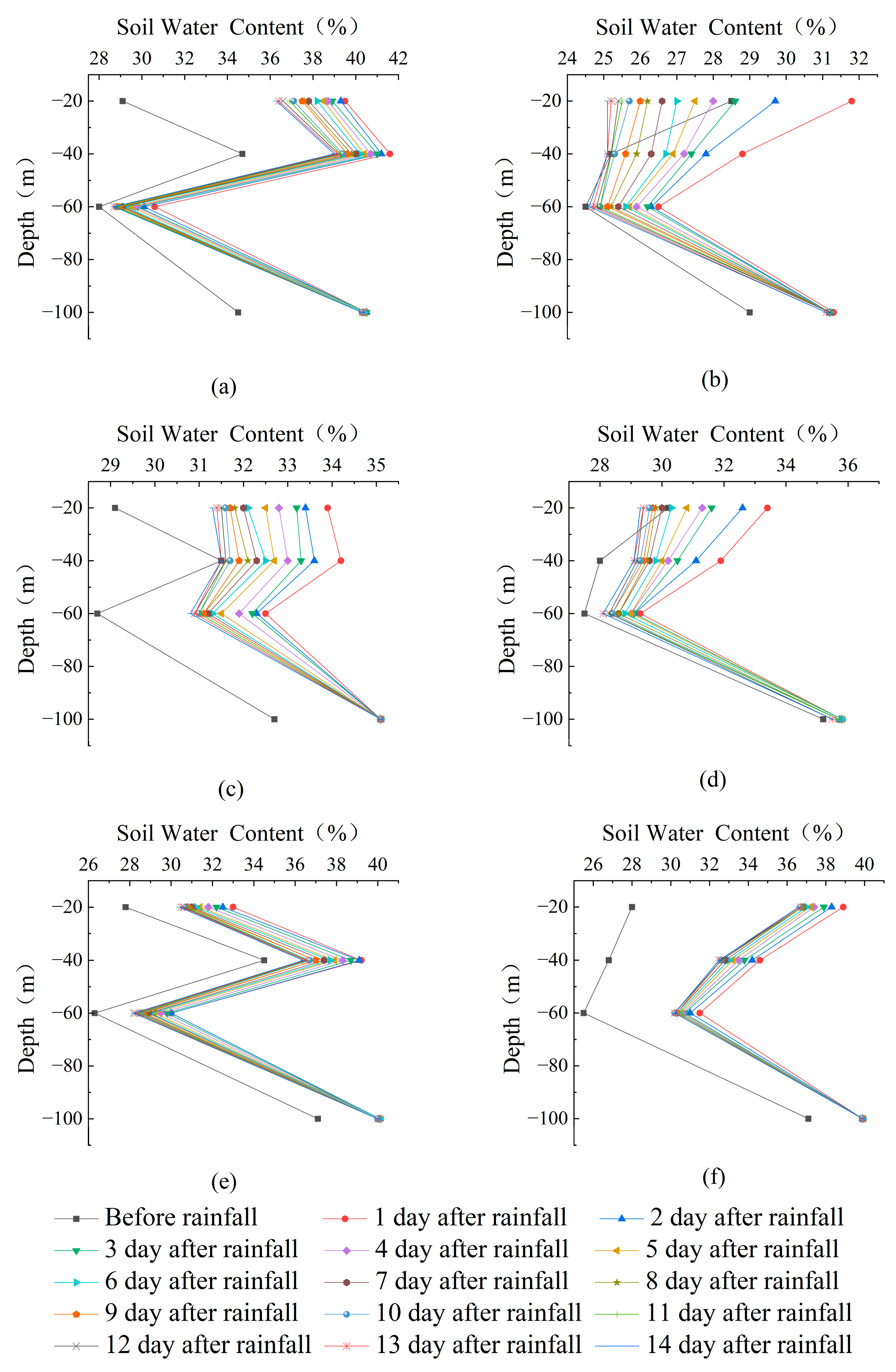Experimental Study of the Soil Water Dissipation Law of Vegetated Slopes under Natural Evaporation Conditions
Abstract
:1. Introduction
2. Materials and Methods
2.1. Model of the Slope
2.2. Test Soil Sample
2.3. Experimental Equipment and Scheme
3. Results and Discussion
3.1. Meteorological Conditions during the Experimental Period
3.2. Initial Water Distribution of the Slope
3.3. Soil Water Change in Slopes under Natural Evaporation Conditions
3.3.1. The Law of Total Variation in Slope Soil Water under Natural Evaporation Conditions
3.3.2. Soil Water Dissipation Law of Bare Slopes under Natural Evaporation Conditions
3.3.3. Soil Water Dissipation Law of Vegetated Slopes under Natural Evaporation Conditions
3.3.4. Soil Water Dissipation Model of a Slope under Natural Evaporation Conditions
3.4. Slope Soil Water Dissipation-Related Factors Analysis
4. Conclusions
- (1)
- Soil water dissipation from the bare slope was more significant on the first day after the rainfall ended but became milder in the following 14 days. The slope ratio has little impact on the dynamic change in water content in bare slopes under natural evaporation conditions. The main influencing factors are soil depth and evaporation time. A greater soil depth leads to a lower rate of soil water dissipation.
- (2)
- The greater the slope ratio of vegetated slopes, the greater the amount of soil water dissipation within a 40 cm range. However, there is no significant difference in soil water dissipation at depths of 60 cm and 100 cm for different slope ratios of vegetated slopes. Since the soil water dissipation rate decreases with time, the change in soil water dissipation over time can be modeled by the logarithmic function Δw = a × ln(Δt) + b.
- (3)
- Pearson correlation analysis revealed that slope conditions, such as slope ratio and vegetation, are the primary factors influencing soil water dissipation under natural evaporation conditions after rainfall. Meteorological factors have less influence on soil water dissipation, although wind speed, humidity, and temperature have a significant impact on soil water dissipation in the 20–40 cm, 0–40 cm, and 0–20 cm soil layers, respectively. Solar radiation, on the other hand, has little effect on soil water dissipation in each soil layer.
Author Contributions
Funding
Institutional Review Board Statement
Informed Consent Statement
Data Availability Statement
Conflicts of Interest
References
- Shi, G.; Yang, X.; Chen, W.; Chen, H.; Zhang, J.; Tao, Z. Characteristics of failure area and failure mechanism of a landslide in Yingjiang County, Yunnan, China. Recent Landslides 2020, 18, 721–735. [Google Scholar] [CrossRef]
- Wang, M.; Liu, Q.; Luo, R. Evaluating ecological effects of roadside slope restoration techniques: A global meta-analysis. J. Environ. Manag. 2021, 281, 111867. [Google Scholar] [CrossRef]
- Fu, H.; Zha, H.; Zeng, L.; Chen, C.; Jia, C.; Bian, H. Research progress on ecological protection technology of highway slope: Status and challenges. Transp. Saf. Environ. 2020, 2, 3–17. [Google Scholar] [CrossRef]
- Zhou, X.; Fu, D.; Wan, J.; Xiao, H.; He, X.; Li, Z.; Deng, Q. The Shear Strength of Root–Soil Composites in Different Growth Periods and Their Effects on Slope Stability. Appl. Sci. 2023, 13, 11116. [Google Scholar] [CrossRef]
- Wang, X.; Wang, Y.; Ma, C.; Wang, Y.; Li, T.; Dai, Z.; Wang, L.; Qi, Z.; Hu, Y. The Hydrological and Mechanical Effects of Forests on Hillslope Soil Moisture Changes and Stability Dynamics. Forests 2023, 14, 507. [Google Scholar] [CrossRef]
- Feng, X.; Fu, B.; Piao, S.; Wang, S.; Ciais, P.; Zeng, Z.; Lü, Y.; Zeng, Y.; Li, Y.; Jiang, X.; et al. Revegetation in China’s Loess Plateau is approaching sustainable water resource limits. Nat. Clim. Chang. 2016, 6, 1019–1022. [Google Scholar] [CrossRef]
- Lal, P.; Shekhar, A.; Gharun, M.; Das, N.N. Spatiotemporal evolution of global long-term patterns of soil moisture. Sci. Total Environ. 2023, 867, 161470. [Google Scholar] [CrossRef]
- Katul, G.G.; Oren, R.; Manzoni, S.; Higgins, C.; Parlange, M.B. Evapotranspiration: A process driving mass transport and energy exchange in the soil-plant-atmosphere-climate system. Rev. Geophys. 2012, 50. [Google Scholar] [CrossRef]
- Scharwies, J.D.; Dinneny, J.R. Water transport, perception, and response in plants. J. Plant Res. 2019, 132, 311–324. [Google Scholar] [CrossRef]
- Zhu, H.; Zhang, L.M.; Garg, A. Investigating plant transpiration-induced soil suction affected by root morphology and root depth. Comput. Geotech. 2018, 103, 26–31. [Google Scholar] [CrossRef]
- Zhang, Q.; Wei, W.; Chen, L.; Yang, L.; Luo, Y.; Cai, A. Plant traits in influencing soil moisture in semiarid grasslands of the Loess Plateau, China. Sci. Total Environ. 2020, 718, 137355. [Google Scholar] [CrossRef]
- Marín-Castro, B.E.; Negrete-Yankelevich, S.; Geissert, D. Litter thickness, but not root biomass, explains the average and spatial structure of soil hydraulic conductivity in secondary forests and coffee agroecosystems in Veracruz, Mexico. Sci. Total Environ. 2017, 607–608, 1357–1366. [Google Scholar] [CrossRef]
- van Loon, M.P.; Schieving, F.; Rietkerk, M.; Dekker, S.; Sterck, F.; Anten, N.N.P.R. How Light Competition between Plants Affects their Response to Climate Change. Procedia Environ. Sci. 2015, 29, 66. [Google Scholar] [CrossRef]
- Du, M.; Zhang, J.; Wu, Y.; Liu, H.; Wang, Z.; Liu, C.; Yang, Q.; Hu, Y.; Bao, Z.; Liu, Y.; et al. Evaluating the contribution of different environmental drivers to changes in evapotranspiration and soil moisture, a case study of the Wudaogou Experimental Station. J. Contam. Hydrol. 2021, 243, 103912. [Google Scholar] [CrossRef]
- Xu, Y.; Zhu, G.; Wan, Q.; Yong, L.; Ma, H.; Sun, Z.; Zhang, Z.; Qiu, D. Effect of terrace construction on soil moisture in rain-fed farming area of Loess Plateau. J. Hydrol. Reg. Stud. 2021, 37, 100889. [Google Scholar] [CrossRef]
- Liu, X.; Tang, Y.; Cheng, X.; Jia, Z.; Li, C.; Ma, S.; Zhai, L.; Zhang, B.; Zhang, J. Comparison of Changes in Soil Moisture Content Following Rainfall in Different Subtropical Plantations of the Yangtze River Delta Region. Water 2021, 13, 914. [Google Scholar] [CrossRef]
- Liang, Z.; Liu, H.; Zhao, Y.; Wang, Q.; Wu, Z.; Deng, L.; Gao, H. Effects of rainfall intensity, slope angle, and vegetation coverage on the erosion characteristics of Pisha sandstone slopes under simulated rainfall conditions. Environ. Sci. Pollut. Res. 2019, 27, 17458–17467. [Google Scholar] [CrossRef]
- Zhang, J.; Duan, L.; Liu, T.; Chen, Z.; Wang, Y.; Li, M.; Zhou, Y. Experimental analysis of soil moisture response to rainfall in a typical grassland hillslope under different vegetation treatments. Environ. Res. 2022, 213, 113608. [Google Scholar] [CrossRef] [PubMed]
- Ju, X.; Gao, L.; She, D.; Jia, Y.; Pang, Z.; Wang, Y. Impacts of the soil pore structure on infiltration characteristics at the profile scale in the red soil region. Soil Tillage Res. 2024, 236, 105922. [Google Scholar] [CrossRef]
- Dai, L.; Guo, X.; Zhang, F.; Du, Y.; Ke, X.; Li, Y.; Cao, G.; Li, Q.; Lin, L.; Shu, K.; et al. Seasonal dynamics and controls of deep soil water infiltration in the seasonally-frozen region of the Qinghai-Tibet plateau. J. Hydrol. 2019, 571, 740–748. [Google Scholar] [CrossRef]
- Wei, W.; Feng, X.; Yang, L.; Chen, L.; Feng, T.; Chen, D. The effects of terracing and vegetation on soil moisture retention in a dry hilly catchment in China. Sci. Total Environ. 2019, 647, 1323–1332. [Google Scholar] [CrossRef] [PubMed]
- Gardner, W.R. Mathematics of isothermal water conduction in unsaturated soils. Highw. Res. Board Spec. Rep. 1958, 40, 78–87. [Google Scholar]
- Bordoni, M.; Vivaldi, V.; Alessia Giarola Valentino, R.; Bittelli, M.; Meisina, C. Comparison between mechanical and hydrological reinforcement effects of cultivated plants on shallow slope stability. Sci. Total Environ. 2024, 912, 168999. [Google Scholar] [CrossRef] [PubMed]
- McColl, K.A.; Alemohammad, S.H.; Akbar, R.; Konings, A.G.; Yueh, S.; Entekhabi, D. The global distribution and dynamics of surface soil moisture. Nat. Geosci. 2017, 10, 100–104. [Google Scholar] [CrossRef]
- Vereecken, H.; Huisman, J.A.; Pachepsky, Y.; Montzka, C.; van der Kruk, J.; Bogena, H.; Weihermüller, L.; Herbst, M.; Martinez, G.; Vanderborght, J. On the spatio-temporal dynamics of soil moisture at the field scale. J. Hydrol. 2014, 516, 76–96. [Google Scholar] [CrossRef]
- Hou, X.; Li, T.; Vanapalli, S.K.; Xi, Y. Water percolation in a thick unsaturated loess layer considering the ground-atmosphere interaction. Hydrol. Process. 2018, 33, 794–802. [Google Scholar] [CrossRef]
- Warren, J.M.; Renée Brooks, J.; Dragila, M.I.; Meinzer, F.C. In situ separation of root hydraulic redistribution of soil water from liquid and vapor transport. Oecologia 2011, 166, 899–911. [Google Scholar] [CrossRef] [PubMed]
- Li, C.-Q.; Wu, P.; Li, X.; Zhou, T.; Sun, S.S.; Wang, Y.; Luan, X.B.; Yu, X. Spatial and temporal evolution of climatic factors and its impacts on potential evapotranspiration in Loess Plateau of Northern Shaanxi, China. Sci. Total Environ. 2017, 589, 165–172. [Google Scholar] [CrossRef]
- Fu, J.; Gong, Y.; Zheng, W.; Zou, J.; Zhang, M.; Zhang, Z.; Qin, J.; Liu, J.; Quan, B. Spatial-temporal variations of terrestrial evapotranspiration across China from 2000 to 2019. Sci. Total Environ. 2022, 825, 153951. [Google Scholar] [CrossRef]
- Czarnecka, M.; Nidzgorska-Lencewicz, J. The effect of the main meteorological elements on the 24 hour variability of moisture of soil under rye and potato. Pol. J. Nat. Sci. 2006, 21, 475–486. [Google Scholar]
- Tang, M.; Li, W.; Gao, X.; Wu, P.; Li, H.; Ling, Q.; Zhang, C. Land use affects the response of soil moisture and soil temperature to environmental factors in the loess hilly region of China. PeerJ 2022, 10, e13736. [Google Scholar] [CrossRef] [PubMed]
- MacDonald, M.K.; Pomeroy, J.W.; Essery, R.L.H. Water and energy fluxes over northern prairies as affected by chinook winds and winter precipitation. Agric. For. Meteorol. 2018, 248, 372–385. [Google Scholar] [CrossRef]
- Xiao, B.; Bowker, M.A. Moss-biocrusts strongly decrease soil surface albedo, altering land-surface energy balance in a dryland ecosystem. Sci. Total Environ. 2020, 741, 140425. [Google Scholar] [CrossRef] [PubMed]














| Plastic Limit (%) | Liquid Limit (%) | Natural Density (g/cm3) | Maximum Dry Density (g/cm3) | Optimum Water Content (%) |
|---|---|---|---|---|
| 23.0 | 41.0 | 1.50 | 1.750 | 20.0 |
| Types of Slope | Ratio of Slope | Soil Depth/cm | Δw = a × ln(Δt) + b | ||
|---|---|---|---|---|---|
| a | b | R2 | |||
| Bare Slope | 1:1.5 | 20 | 1.073 | 1.401 | 0.914 |
| 40 | 0.886 | 1.198 | 0.953 | ||
| 60 | 0.664 | 0.964 | 0.979 | ||
| 1:1.75 | 20 | 1.046 | 1.828 | 0.991 | |
| 40 | 0.944 | 1.334 | 0.973 | ||
| 60 | 0.657 | 1.022 | 0.969 | ||
| 1:2 | 20 | 0.991 | 1.662 | 0.992 | |
| 40 | 0.966 | 1.107 | 0.913 | ||
| 60 | 0.667 | 0.874 | 0.929 | ||
| Vegetated Slope | 1:1.5 | 20 | 2.162 | 3.065 | 0.980 |
| 40 | 1.279 | 1.813 | 0.965 | ||
| 60 | 0.663 | 0.913 | 0.944 | ||
| 1:1.75 | 20 | 1.558 | 2.544 | 0.989 | |
| 40 | 1.106 | 2.056 | 0.996 | ||
| 60 | 0.521 | 1.009 | 0.953 | ||
| 1:2 | 20 | 1.099 | 2.414 | 0.965 | |
| 40 | 0.992 | 2.021 | 0.982 | ||
| 60 | 0.548 | 1.132 | 0.974 | ||
| Soil Depth | Meteorological Factors | Slope Conditions | ||||
|---|---|---|---|---|---|---|
| Wind Speed | Temperature | Humidity | Solar Radiation | Vegetation | Ratio of Slope | |
| 0–20 cm | 0.0329 | −0.0507 * | −0.05003 * | −0.01484 | −0.155 ** | −0.672 ** |
| 20–40 cm | 0.0882 ** | −0.0516 * | −0.0368 | −0.01995 | −0.431 ** | 0.551 ** |
| 40–60 cm | −0.00554 | −0.0306 | −0.0272 | 0.00244 | −0.419 ** | −0.236 ** |
| 60–100 cm | 0.043 | −0.0321 | −0.0255 | −0.01236 | −0.481 ** | 0.817 ** |
| 0–100 cm | 0.0202 | −0.0468 * | −0.0445 * | −0.00629 | −0.800 ** | 0.0688 ** |
Disclaimer/Publisher’s Note: The statements, opinions and data contained in all publications are solely those of the individual author(s) and contributor(s) and not of MDPI and/or the editor(s). MDPI and/or the editor(s) disclaim responsibility for any injury to people or property resulting from any ideas, methods, instructions or products referred to in the content. |
© 2024 by the authors. Licensee MDPI, Basel, Switzerland. This article is an open access article distributed under the terms and conditions of the Creative Commons Attribution (CC BY) license (https://creativecommons.org/licenses/by/4.0/).
Share and Cite
Xiao, H.; Liu, Z.; Wan, J.; Chen, J.; Shi, Y. Experimental Study of the Soil Water Dissipation Law of Vegetated Slopes under Natural Evaporation Conditions. Appl. Sci. 2024, 14, 1105. https://doi.org/10.3390/app14031105
Xiao H, Liu Z, Wan J, Chen J, Shi Y. Experimental Study of the Soil Water Dissipation Law of Vegetated Slopes under Natural Evaporation Conditions. Applied Sciences. 2024; 14(3):1105. https://doi.org/10.3390/app14031105
Chicago/Turabian StyleXiao, Henglin, Zebang Liu, Juan Wan, Junyi Chen, and Yunfeng Shi. 2024. "Experimental Study of the Soil Water Dissipation Law of Vegetated Slopes under Natural Evaporation Conditions" Applied Sciences 14, no. 3: 1105. https://doi.org/10.3390/app14031105
APA StyleXiao, H., Liu, Z., Wan, J., Chen, J., & Shi, Y. (2024). Experimental Study of the Soil Water Dissipation Law of Vegetated Slopes under Natural Evaporation Conditions. Applied Sciences, 14(3), 1105. https://doi.org/10.3390/app14031105





